Dr. Robyn Roberts, Field Crops Pathologist and CSU Assistant Professor
Robyn.Roberts@colostate.edu, 970-491-8239
June 12, 2025
Summary: Several diseases were found during the Colorado Wheat Field Days this year, but most were at very low levels. Viral diseases are the greatest economic concern right now. There are a spattering of various leaf, head, and root diseases caused by fungi, but they should not have much of a yield impact and it is too close to harvest to apply fungicides. Symptoms consistent with bacterial diseases were also found.
Disease Observations
Mosaic virus complex: Viruses continue to be the major disease problem this year, with many reports of symptomatic fields across Colorado, including mosaic patterns and yellow streaks (Figure 1). The wheat mosaic virus complex is caused by one or more viruses, including triticum mosaic virus (TriMV), wheat streak mosaic virus (WSMV), and/or high plains wheat mosaic virus (HPWMoV). It is transmitted by the wheat curl mite, which may cause ‘curling’ symptoms on their own.
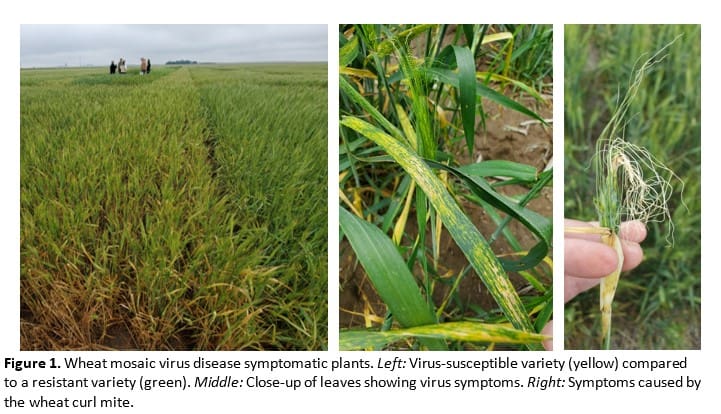
Management and prevention: There is no treatment for the disease, and no miticides are effective against the vector (the wheat curl mite). Controlling volunteer wheat and planting mite- and virus- resistant varieties are the best control measures. To prevent viruses next year, volunteer wheat should be eliminated between harvest and planting, both in fields and surrounding areas, and be killed for at least 2 weeks before planting (Figure 2). Volunteer corn and other grasses can also harbor the mites, so general weed control is also essential.
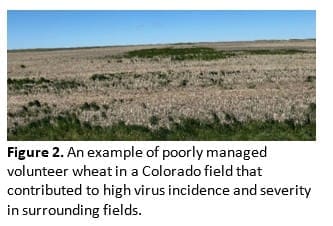
Stripe Rust
Stripe rust was observed at low levels in several fields across Colorado (Figure 3). The cool, wet weather has been conducive to disease development, but the stripe rust inoculum levels, as well as incidence and severity, remain low.
Management and Prevention: It is too close to harvest to apply a fungicide, but the hot upcoming temperatures should suppress the disease. Symptoms were not typically observed on flag leaves, and the disease is not expected to be at a high enough level to have much of an impact on yield.

Fusarium head blight (head scab)
Low levels of Fusarium head blight (FHB) were observed at several sites across the state (Figure 4). The fungal pathogen requires wet conditions, so FHB is more common after significant, prolonged rainfall, much like what we recently encountered. The fungus infects flowers, so the timing of the wet, warm weather with flowering provided optimal conditions for disease development.
The pathogen also produces a mycotoxin called deoxynivalenol (DON), which is a toxic chemical to people and livestock. Elevated levels of mycotoxin can accumulate even under minor disease conditions, and high numbers of damaged, wrinkled, or ‘tombstone’ grains can indicate high levels of mycotoxin. The spores produced from the initial infection can produce additional spores that infect other heads. Significant disease problems can therefore occur if wheat stands are uneven with late flowering tillers.
Management and Prevention: Penn State University and colleagues at the Fusarium Scab Initiative have developed a risk assessment tool to predict the likelihood of FHB: https://tinyurl.com/2jcvcze9.
Infected corn or wheat residue can be a significant source of inoculum. Managing residue and applying a fungicide that is labeled for FHB at early wheat flowering are the best control methods when the pressure is moderate or severe, in addition to genetic resistance.
Cephalosporium Stripe
Cephalosporium stripe disease was observed in Roggen at low levels, sporadically across a field (Figure 5). Cephalosporium stripe is a fungal wilt disease that usually develops when there is high residue on the soil and limited or short crop rotations have been implemented. The fungus survives in wheat residue over the winter and infects crops in the spring when the weather is cool and wet. This disease has not been particularly problematic in Colorado in the past, but the unusually extended cool, wet weather has been conducive to disease development in some areas.
Management and prevention: Unfortunately, there are no fungicides available to control the disease so applying fungicides will not help. Document the incidence and take note of whether there is a lot of residue build-up in your field, and if the crop was recently rotated away from wheat. The predicted warmer temperatures should also help suppress the disease.
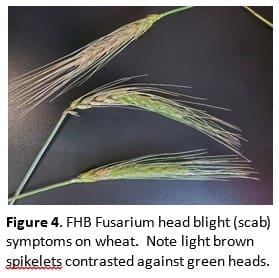
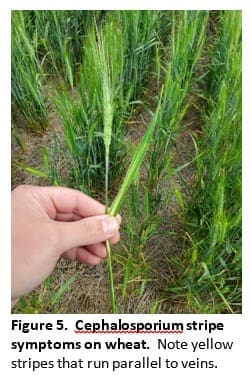
Crown Rot

Crown rot was sporadically observed across the state and is caused by the same fungus as FHB (Figure 6). Seeds infected with FHB may or may not show symptoms or signs of FHB but can still be infected. If infested seed is planted, root rot and crown rot may develop, as the fungus emerges and infects wheat plants directly from the seed. Prolonged drought stress coupled with high soil temperature in the fall promotes early disease development.
Management and Prevention: Using fungicide-treated seed helps control infection and disease development, and crop rotation is essential to preventing Fusarium from building up in residue.
Bacterial Streak
Symptoms consistent with bacterial streak were observed in several fields across Colorado (Figure 7). Symptoms initially appear as small, water-soaked areas between leaf veins, which eventually become dead spots after a few days.
Management and Prevention: Use clean seed sources and do not plant contaminated seeds. There are not pesticides that are effective against bacterial streak disease.
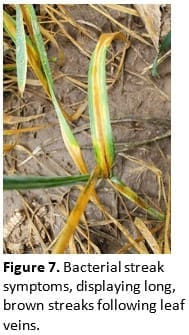
Blotch and Spot Disease
Blotch and spot diseases caused by fungi were observed on both leaves and glumes at low levels across the state (Figure 8), and often appear together. Tan spot appears as necrotic (dead, brown) diamond-shaped spots surrounded by yellow halos or borders. Stagonospora leaf blotch symptoms develop as small, yellow spots on lower leaves that develop into elongated, dark leaves as the season progresses. Wet, rainy weather, high humidity, and moderate temperatures (~68-75°F) favor disease development.
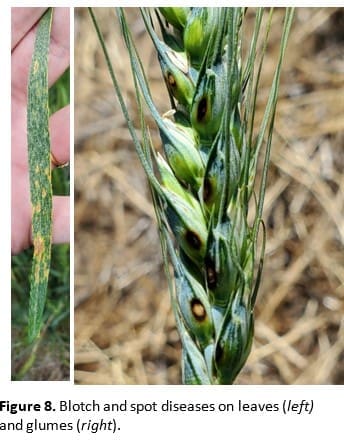
Management and prevention: Typically, as the weather warms, blotch and spot diseases do not continue to be a problem in Colorado, so fungicide applications are not usually recommended. As long as the weather continues to get warmer, disease incidence and severity should decrease. Because the fungus survives in wheat residue, rotating crops will help reduce the number of spores in a field the following years. Fungicide seed treatments also help protect seedlings from infection.
Loose Smut
Low levels of loose smut were found in one wheat variety in Orchard (Figure 9). The fungal spores completely replace the head tissue with powdery, dark spores, which may be visible when the head is still inside the boot. Loose smut is not typically a disease problem in Colorado.
Management and prevention: Fungicide seed treatments can help prevent loose smut.
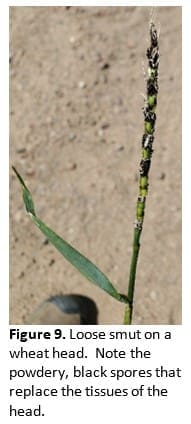
Additional resources
- Colorado Wheat Entomology Newsletter: https://coloradowheat.org/category/news-events/wheat-pest-and-disease-update/
- Fusarium risk tool: https://www.wheatscab.psu.edu/?ct=YTo1OntzOjY6InNvdXJjZSI7YToyOntpOjA7czo1OiJlbWFpbCI7aToxO2k6NjM7fXM6NToiZW1haWwiO2k6NjM7czo0OiJzdGF0IjtzOjIyOiI2NjA1OWYxMzk5MmJjMzY4ODcyMDIyIjtzOjQ6ImxlYWQiO3M6MjoiMjAiO3M6NzoiY2hhbm5lbCI7YToxOntzOjU6ImVtYWlsIjtpOjYzO319
- Information about the ‘green bridge’ and risks for viral diseases due to volunteer wheat: https://eupdate.agronomy.ksu.edu/article_new/spring-emerged-volunteer-wheat-should-producers-worry-about-wheat-streak-mosaic-virus-and-the-green-bridge-436-4
- Fungicide Efficacy for Control of Wheat Diseases Table: https://cropprotectionnetwork.org/publications/fungicide-efficacy-for-control-of-wheat-diseases
Contributors: Many thanks to Sally Jones-Diamond, Ron Meyer, Laura Potorff, Diego Gutierrez, Lukas Migliano, Jason Webb, Tyler Benninghoven, and Dr. Esten Mason who contributed to this report.
May 28, 2025
Summary: Viruses were detected in Colorado. Watch for stripe rust and other fungal leaf diseases.
Disease Observations
Mosaic virus complex: Viruses continue to be the major disease problem this year, with many reports of symptomatic fields across Colorado. Severalplants from Kit Carson, Washington, and Baca counties were confirmed with the wheat mosaic virus complex disease (Figure 1). The wheat mosaic virus complex is caused by one or more viruses, including triticum mosaic virus (TriMV), wheat streak mosaic virus (WSMV), and/or high plains wheat mosaic virus (HPWMoV). It is transmitted by the wheat curl mite, and symptoms appear as yellow streaks and mosaic patterns on leaves.
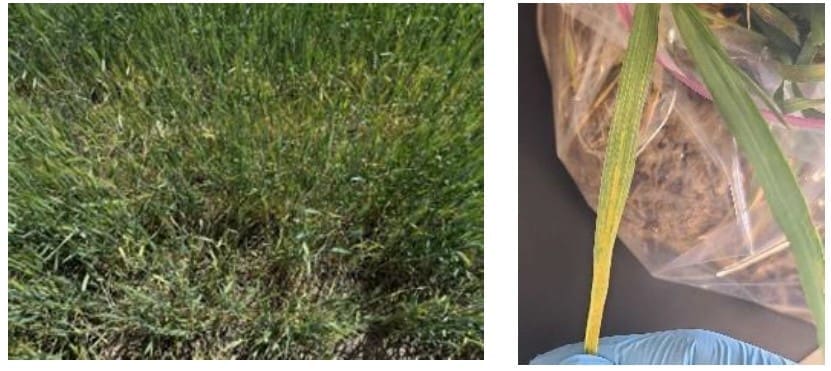
Management and prevention: Once plants show virus symptoms there is no treatment for the disease, and no miticides are effective against the vector (the wheat curl mite). Controlling volunteer wheat and planting mite- and virus- resistant varieties are the best control measures. To prevent viruses next year, volunteer wheat should be eliminated between harvest and planting, both in fields and surrounding areas, and be dead at least 14 days before fall planting (Figure 2).
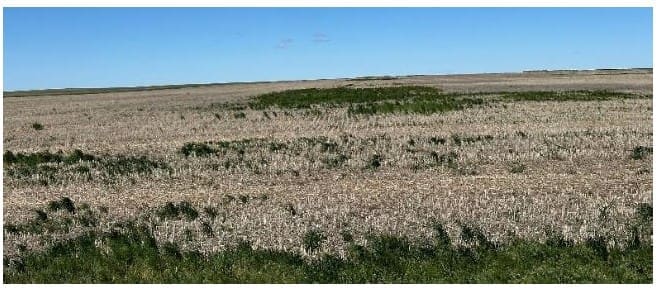
Disease Watch and Management
Stripe Rust
Stripe rust was reported last week in the Southwest corner of Nebraska. I expect that stripe rust risk will still remain low this year, but now is the time to scout for stripe rust. There are currently no reports of stripe rust in Colorado or Kansas.
Tan Spot and Stagonospora leaf blotch
Tan spot and Stagonospora leaf blotch diseases are caused by fungi that infect leaves and can begin to appear this time of year. However, both diseases are dependent on wet conditions, high humidity, and moderate temperatures (~68-75°F), and the fungi survive in infected residue. Typically, these diseases do not cause significant yield losses in Colorado, and are often found together on leaves.
Management and prevention: Because the fungus survives in wheat residue, rotating crops will help reduce the number of spores in a field the following years. Fungicide seed treatments also help protect seedlings from infection. Foliar fungicides are generally not recommended in Colorado for treatment of Tan Spot or Stagonospora leaf blotch, except in very rare high-disease cases.
Additional Resources
- Colorado Wheat Entomology Newsletter: https://coloradowheat.org/category/news-events/wheat-pest-and-disease-update/
- Fusarium risk tool:
https://www.wheatscab.psu.edu/?ct=YTo1OntzOjY6InNvdXJjZSI7YToyOntpOjA7czo1OiJlbWFpbCI7aToxO2k6NjM7fXM6NT oiZW1haWwiO2k6NjM7czo0OiJzdGF0IjtzOjIyOiI2NjA1OWYxMzk5MmJjMzY4ODcyMDIyIjtzOjQ6ImxlYWQiO3M6MjoiMjAiO 3M6NzoiY2hhbm5lbCI7YToxOntzOjU6ImVtYWlsIjtpOjYzO319 - Information about the ‘green bridge’ and risks for viral diseases due to volunteer wheat:
https://eupdate.agronomy.ksu.edu/article_new/spring-emerged-volunteer-wheat-should-producers-worry-about-wheat-streak-mosaic-virus-and-the-green-bridge-436-4 - Fungicide Efficacy for Control of Wheat Diseases Table: https://cropprotectionnetwork.org/publications/fungicide-efficacy-for-control-of-wheat-diseases
CONTRIBUTORS: Many thanks to Sally Jones-Diamond and Dr. Esten Mason who contributed to this report.
April 30, 2025
Summary: Viruses were detected in Colorado. Watch for stripe rust, viruses, and other fungal leaf diseases.
Disease Observations
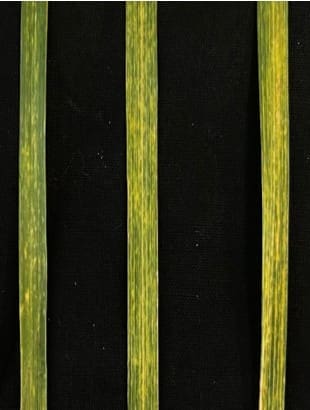
Mosaic virus complex: Plants exhibiting symptoms consistent with wheat mosaic virus complex disease were collected from Kit Carson County (Figure 1). The wheat mosaic virus complex is caused by one or more viruses, including triticum mosaic virus (TriMV), wheat streak mosaic virus (WSMV), and/or high plains wheat mosaic virus (HPWMoV). It is transmitted by the wheat curl mite, and symptoms appear as yellow streaks and mosaic patterns on leaves.
Management and prevention: There is no treatment for virus-infected plants, and no miticides are effective against the vector (the wheat curl mite). Controlling volunteer wheat and planting mite- and virus-resistant varieties are the best control measures. Volunteer wheat should be eliminated between harvest and planting, both in fields and surrounding areas, and be dead at least 14 days before fall planting.
Disease Watch and Management
Stripe Rust
I expect that stripe rust risk will remain low this year, but now is the time to scout for stripe rust. There are currently no reports of stripe rust in Colorado or Kansas, and, while the weather has overall been conducive for stripe rust disease development in Colorado, the spores do not overwinter here and instead blow up in wind currents from southern states (Texas and Oklahoma) every spring. However, the fungus requires both cool and wet weather, and the dry winter and spring in Texas has suppressed stripe rust sporulation. Stripe rust was initially reported in Texas in March, which is quite late in the season, and levels have remained low. Very low levels of stripe rust were reported in Oklahoma. The low inoculum levels limit the number of spores that can survive and migrate to Colorado to cause disease, reducing our stripe rust risk this season.
Viruses
We found that many of our samples in 2023 and 2024 had very high levels of TriMV, which is a closely related but different virus from WSMV (Figure 3). The Wsm2 resistance that works against WSMV does not work against TriMV.
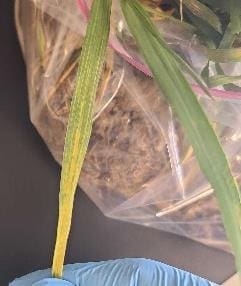
Tan Spot and Stagonospora leaf blotch
Tan spot and Stagonospora leaf blotch diseases are caused by fungi that infect leaves and can begin to appear this time of year. However, both diseases are dependent on wet conditions, high humidity, and moderate temperatures (~68-75°F), and the fungi survive in infected residue. Typically, these diseases do not cause significant yield losses in Colorado and are often found together on leaves (Figure 4).

Management and prevention: Because the fungus survives in wheat residue, rotating crops will help reduce the number of spores in a field the following years. Fungicide seed treatments also help protect seedlings from infection. Foliar fungicides are generally not recommended in Colorado for treatment of Tan Spot or Stagonospora leaf blotch, except in very rare high-disease cases.
Additional resources
- Colorado Wheat Entomology Newsletter: https://coloradowheat.org/category/news-events/wheat-pest-and-disease-update/
- Fusarium risk tool: https://www.wheatscab.psu.edu/?ct=YTo1OntzOjY6InNvdXJjZSI7YToyOntpOjA7czo1OiJlbWFpbCI7aToxO2k6NjM7fXM6NToiZW1haWwiO2k6NjM7czo0OiJzdGF0IjtzOjIyOiI2NjA1OWYxMzk5MmJjMzY4ODcyMDIyIjtzOjQ6ImxlYWQiO3M6MjoiMjAiO3M6NzoiY2hhbm5lbCI7YToxOntzOjU6ImVtYWlsIjtpOjYzO319
- Information about the ‘green bridge’ and risks for viral diseases due to volunteer wheat: https://eupdate.agronomy.ksu.edu/article_new/spring-emerged-volunteer-wheat-should-producers-worry-about-wheat-streak-mosaic-virus-and-the-green-bridge-436-4
- Fungicide Efficacy for Control of Wheat Diseases Table: https://cropprotectionnetwork.org/publications/fungicide-efficacy-for-control-of-wheat-diseases
Contributors: Many thanks to Sally Jones-Diamond and Dr. Esten Mason, who contributed to this report.